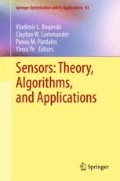Abstract
Electroencephalography (EEG) is a non-invasive low cost monitoring exam that is used for the study of the brain in every hospital and research labs. Time series recorded from EEG sensors can be studied from the perspective of computational neuroscience and network theory to extract meaningful features of the brain. In this chapter we present a network clustering approach for studying synchronization phenomena as captured by cross-correlation in EEG recordings. We demonstrate the proposed clustering idea in simulated data and in EEG recordings from patients with epilepsy.
Access this chapter
Tax calculation will be finalised at checkout
Purchases are for personal use only
References
J. Abello, P.M. Pardalos, and M.G.C. Resende. On maximum clique problems in very large graphs. American Mathematical Society, 50:119–130, 1999.
V. Boginski, S. Butenko, and P.M. Pardalos. Mining market data: a network approach. Comput. Oper. Res., 33(11):3171–3184, 2006.
R.K. Ahuja, T.L. Magnanti, and J.B. Orlin. Network Flows: Theory, Algorithms, and Applications. Prentice Hall, Upper Saddle River/Un, 1993.
M. Fiedler. Algebraic connectivity of graphs. Czechoslovak Mathematical Journal, 23:298–305, 1973.
L. Hagen and A.B. Kahng. New spectral methods for ratio cut partitioning and clustering. Computer-Aided Design of Integrated Circuits and Systems, IEEE Transactions, 11(9):1074–1085, 1992.
A. Pothen, H.D. Simon, and K.-P. Liou. Partitioning sparse matrices with eigenvectors of graphs. SIAM. J. Matrix Anal. & Appl., 11:430–452, 1990.
M. Fiedler. A property of eigenvectors of nonnegative symmetric matrices and its application to graph theory. Czechoslovak Mathematical Journal, 25, pp. 619–633, 1975.
J. Shi and J. Malik. Normalized cuts and image segmentation. IEEE Transactions on Pattern Analysis and Machine Intelligence, 22:888–905, 2000.
A.Y. Ng, M.I. Jordan, and Y. Weiss. On spectral clustering: Analysis and an algorithm. In Advances in Neural Information Processing Systems 14, pages 849–856. MIT Press, Boston, 2001.
J Falkner, F Rendl, and H Wolkowicz. A computational study of graph partitioning. Math. Program., 66(2):211–239, 1994.
S.E. Karisch and F. Rendl. Semidefinite programming and graph equipartition. In In Topics in Semidefinite and Interior-Point Methods, pages 77–95. AMS, Providence Rhode island, 1998.
F. Rendl and H. Wolkowicz. A projection technique for partitioning the nodes of a graph. Annals of Operations Research, 58(3):155–179, May 1995.
S. Micheloyannis, V. Sakkalis, M. Vourkas, C.J. Stam, and P.G. Simos. Cortical networks involved in mathematical thinking: Evidence from linear and non-linear cortical synchronization of electrical activity. Neuroscience Letters, 373:212–217, 2005.
M. Ford, J. Goethe, and D. Dekker. Eeg coherence and power changes during a continuous movement task. Int. J. Psychophysiol, vol. 4:99110, 1986.
J.P. Lachaux, E. Rodriguez, J. Martinerie, and F. J. Varela. Measuring phase synchrony in brain signals. Human Brain Mapping, 8:194–208, 1999.
S.M. Pincus. Approximate entropy as a measure of system complexity. Proc Natl Acad Sci, 88:2297–2301, 1991.
Q. Quiroga, A. Kraskov, T. Kreuz, and P. Grassberger. Performance of different synchronization measures in real data: a case study on electroencephalographic signals,. Phys. Rev. E, 65:041903, 2002.
E. Pereda, R. Q. Quiroga, and J. Bhattacharya. Nonlinear multivariate analysis of neurophysiological signals,. Progress in Neurobiology, 77:1–37, 2005.
J. Dauwels, F. Vialatte, and A. Cichocki. Neural Information Processinge, volume 4984 of Lecture Notes in Computer Science, chapter A Comparative Study of Synchrony Measures for the Early Detection of Alzheimers Disease Based on EEG. Springer, Berlin / Heidelberg, 2008.
V. Sakkalis, C.D. Giurcaneanu, P. Xanthopoulos, M. Zervakis, V. Tsiaras, Y. Yang, E. Karakonstantaki, and S. Michelyannis. Assessment of linear and nonlinear synchroniztion measures for analyzing eeg in a mild epileptic paradigm. IEEE transaction on Information technology in biomedicine, 2008. DOI:10.1109/TITB.2008.923141. 13(4):433-441, Jul 2009.
L.D. Iasemidis, D.-S. Shiau, P.M. Pardalos, W. Chaovalitwongse, K. Narayanana, A. Prasad, K. Tsakalis, P.R. Carney, and J.C. Sackellares. Long-term prospective on-line real-time seizure prediction. Clinical Neurophysiology, 116(3):532–544, 2005.
L.D. Iasemidis, D.-S. Shiau, W. Chaovalitwongse J.C. Sackellares, P.M. Pardalos, J.C. Principe, P.R. Carney, A. Prasad, B. Veeramani, and K. Tsakalis. Adaptive epileptic seizure prediction system. IEEE Transactions on Biomedical Engineering, 50(5):616–627, 2003.
Author information
Authors and Affiliations
Corresponding author
Editor information
Editors and Affiliations
Rights and permissions
Copyright information
© 2012 Springer Science+Business Media, LLC
About this chapter
Cite this chapter
Xanthopoulos, P., Arulselvan, A., Pardalos, P.M. (2012). A Spectral Clustering Approach for Modeling Connectivity Patterns in Electroencephalogram Sensor Networks. In: Boginski, V.L., Commander, C.W., Pardalos, P.M., Ye, Y. (eds) Sensors: Theory, Algorithms, and Applications. Springer Optimization and Its Applications(), vol 61. Springer, New York, NY. https://doi.org/10.1007/978-0-387-88619-0_10
Download citation
DOI: https://doi.org/10.1007/978-0-387-88619-0_10
Published:
Publisher Name: Springer, New York, NY
Print ISBN: 978-0-387-88618-3
Online ISBN: 978-0-387-88619-0
eBook Packages: Mathematics and StatisticsMathematics and Statistics (R0)

